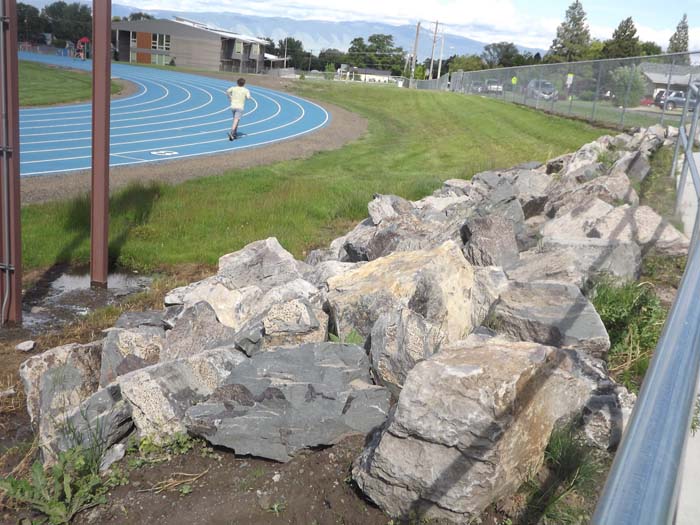New classrooms, security among La Grande schools improvements
Published 6:30 am Saturday, June 20, 2020

- A jogger moves past the new boulder garden the La Grande School District installed at the high school’s track and field complex to replace thick brush. The project is among several improvements the district is making this summer.
LA GRANDE — Two new classrooms, improved security and a decorative boulder garden.
All are on the La Grande School District’s summer projects list. Completing the projects is making for a busy summer for the school district’s physical plant staff and its contractors.
“We want to get as much done as we can before the students come back. We do not want to disrupt classes,” said Joseph Waite, the school district’s bond and facilities manager.
One of the most labor intensive of the improvements this summer will involve adding two classrooms to La Grande Middle School. Both will be on the north portion of the school’s library. The classrooms will occupy 40% of the space the library has, Waite said. The district expects construction to start in early July and finish by late August. The classrooms will help the school accommodate an expected enrollment increase, Waite said, and also make it easier for the school district to meet state social distancing standards to protect people from the coronavirus.
The cracked and crumbling concrete outside La Grande Middle School’s main entrance is getting replaced as well. This will boost safety, especially in the winter. Waite explained once the rough areas are replaced with smooth concrete, it will be easier to remove snow from the expansive entrance area each winter.
Extensive concrete work also will be done at La Grande High School outside the Second Street entrance to its gym and auditorium. All of the concrete in this section, much of which is deteriorating, will be replaced, Waite said.
A second summer project involves the south entrance to the high school track and field complex. Crews removed thick brush about 10-20 feet inside the entry to take away cover where anyone could hide, Waite said.
Now, at least 150 boulders cover the site, and native vegetation likely will be planted in the area.
On the technology front, the installation of additional cameras for monitoring activity in the school district will boost security. The cameras will expand the area the school district can monitor, Waite said. The new cameras will be part of a system with more memory capacity, making it possible for school district officials to look further back at photos for security purposes.
The school district will receive another tech boost when the card key entry system, which almost all of its school buildings have, will be linked into one network. This will allow the card key system to operate much more efficiently, Waite said.
The computerized system, which the school district has had for about four years, is based on coded cards employees use to enter into buildings. It has been efficient to operate, except when a new employee is hired or someone leaves. Then computers at the card key systems of buildings have to be manually uploaded to recognize the new employee’s card or reject the card of the employee who left. This can be a time-consuming process depending on how many buildings an employee has or had access to.
Waite said, for example, that if a new employee needed a card that provides access to all buildings, the uploading process could take two hours. Once the network is established, however, this process will be quick.
Work on reducing radon levels at Willow School and Island City Elementary School also is underway. Radon is a naturally occurring below-ground radioactive, colorless and tasteless gas that can cause health problems when there is prolonged exposure. Testing identified portions of Willow and Island City as having radon levels that need to be lowered.
Much of the mitigation work at Willow and in the principal’s office at Island City involves the installation of vents and exhaust fans to suck out radon gas, preventing it from entering buildings.
Waite said he had hoped to get a head start on summer projects this spring after schools were closed because of the pandemic. The work had to be postponed, though, because it was not known how much money would be available for projects because of the potential financial impact of the coronavirus.
“There was too much financial uncertainty,” Waite said.
Today, however, the school district, Waite said, has a clearer idea of what the range of the fiscal impact might be, allowing it to move ahead on projects this summer.




